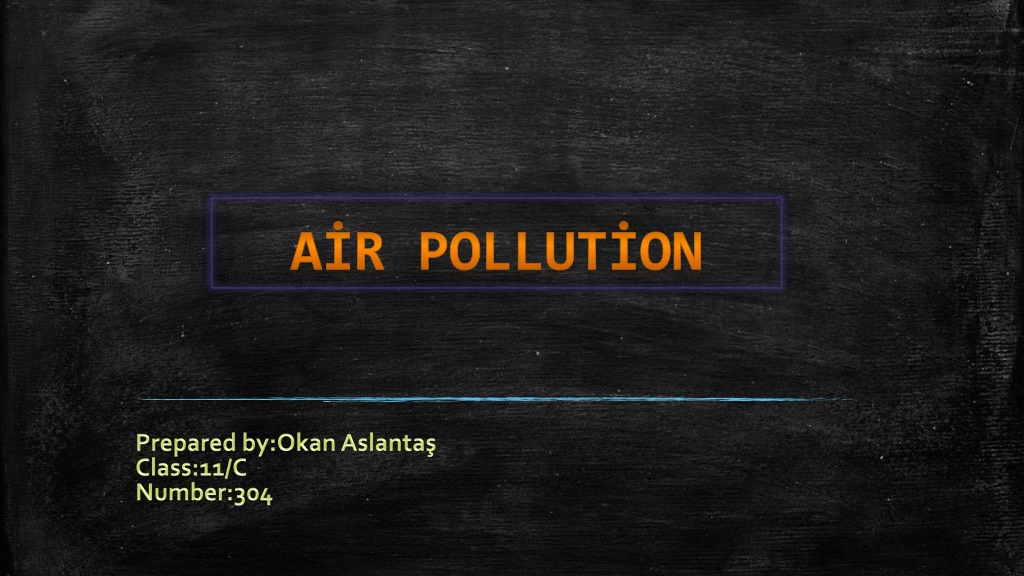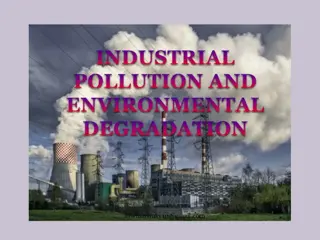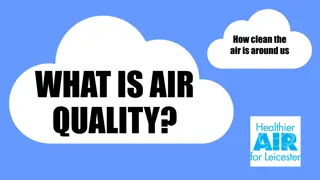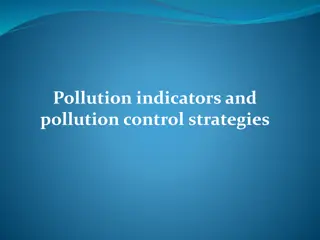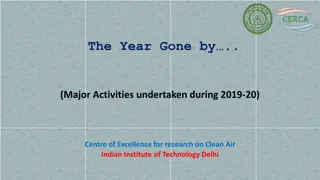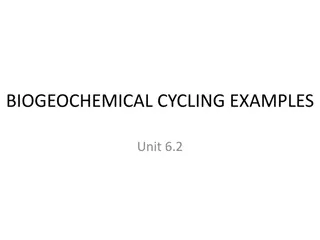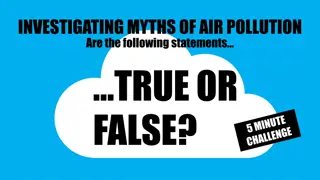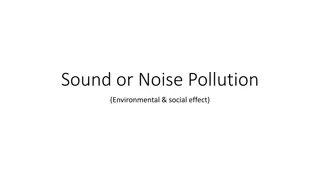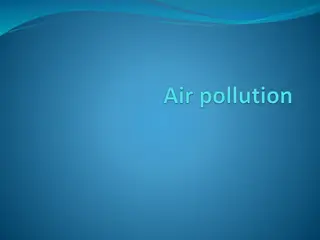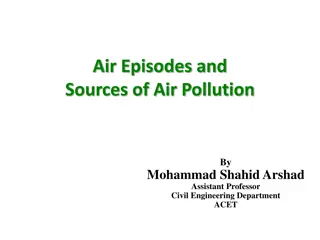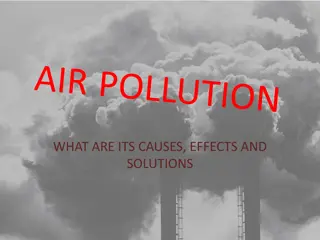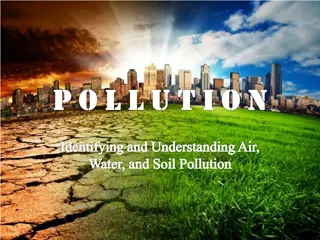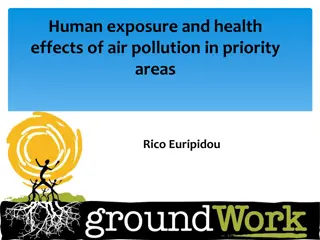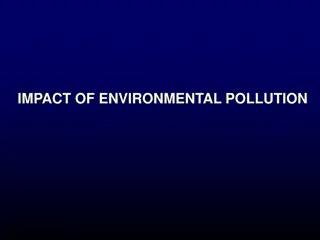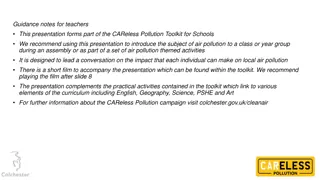Understanding Air Pollution and its Causes
Air pollution is the presence of harmful substances in the air that negatively impact health and the environment. It is caused by factors such as poor quality fuels, exhaust gases, and industrial activities. Different types of air pollution, such as from warming, motor vehicles, and industry, contribute to this global issue.
Download Presentation

Please find below an Image/Link to download the presentation.
The content on the website is provided AS IS for your information and personal use only. It may not be sold, licensed, or shared on other websites without obtaining consent from the author. Download presentation by click this link. If you encounter any issues during the download, it is possible that the publisher has removed the file from their server.
E N D
Presentation Transcript
What Is Air Pollution Air pollution is the amount and density of foreign substances in the air that adversely affect the health of living things and cause material damage. In other words, air pollution is an environmental disaster caused by the atmosphere's excessive use of gases such as carbon dioxide, carbon monoxide and sulfur.. In other words, air pollution is the presence of solid, liquid and gaseous substances in the air in the atmosphere in the amount, density and time that will harm human health, living life and ecological balance. During the production and consumption activities that occur as a result of various activities of people, the air layer is polluted and the living life on Earth is adversely affected.
Causes Of Air Pollution: Used in poor quality fuels. Exhaust gases. The location of the cities. Proper burning of the stove and the heater. Adverse weather conditions. With the use of high quality fuels, proper burning of the stove and the heater will reduce air pollution. Gases from the exhaust of automobiles also cause air pollution. The establishment of our cities in pit places also increases air pollution. Wind speed slows down in cities surrounded by mountains. For this reason, harmful gases in the air can not be moved by the winds. This increases air pollution. Even if the location of our cities is appropriate, adverse weather conditions and wind blowing can cause increased air pollution. In air pollution, of course, pollution that occurs from artificial sources rather than from pollution sources is important. Because today, people are most interested in the air pollution, especially in large residential areas and industrial areas. In this pollution, more people occur as a result of activities.
Types Of Air Pollution: We can divide air pollution resources into three types; 1.Air pollution caused by warming 2.Air pollution caused by motor vehicles 3.Air pollution caused by industry
Air pollution caused by warming For heating purposes, common use of low-calorie and high- sulphurcoal and the application of incorrect burning techniques lead to air pollution.
Air pollution caused by motor vehicles In parallel with population growth and income level rise, exhaust gases from rapidly increasing motor vehicles constitute an important factor in air pollution. To prevent this, the exhaust filter should be checked frequently.
Air pollution caused by industry Selection of wrong location in the establishment of industrial facilities, taking necessary precautions in terms of Environmental Protection (chimney filter, no treatment plant etc.), the use of appropriate technologies, the use of unskilled and high sulphurfuels in energy-generating combustion units, is one of the factors that cause air pollution.
Effects Of Air Pollution Polluted air causes increased respiratory tract diseases in humans. Especially smoke from the lungs to alveolar entering the negative effect. It was determined that the amount of carbon dioxide in the atmosphere increased by 5% as a result of the destruction of forests and land by fossil fuels used in Industry, Industry and heating. This is expected to cause global warming. Continuing
Effects Of Air Pollution EPA is a classification made by the United States Environmental Protection Agency based on the health effects of pollutants(198). Criteria air pollutants are defined concentrations of pollutants that distinguish between acceptable air quality and unhealthy or poor air quality. These limit values are the concentrations of contaminants allowed to be present in the outside environment, taking into account human health and/or environmental effects at certain intervals. The limit values for these pollutants can take different values in different countries and environmental organizations.
Criteria Air Pollutants Carbon monoxide (CO) Nitrogen dioxide (NO2) Sulfur dioxide (SO2) Ozone (O3) Particulate matter (PM) Lead (PB) Volatile organic compounds (UOC) Hydrocarbons
Carbon Monoxide (CO) It is a colourless, odorless gas and occurs when the carbon in fuels does not burn properly. The main source is internal combustion engines (85-95%). Industry, wood burning and forest fires are the main sources of CO emissions. Co alveolar-capillary easily diffuse in the membrane by binding hemoglobin leads to COHb formation in the blood. CO binds 200 times more strongly to Hemoglobin than O2. Therefore, preventing the transfer of O2 to the tissues causes suffocation.
Nitrogen Oxides (NOx) Nitrogen oxides (NOx) are highly reactive gases formed at high temperatures (1200 OC). Many types of nitrogen oxides are colorless and odorless and do not dissolve in water. For this reason, the upper respiratory tract is eliminated until the most extreme of the respiratory tract is inhaled and they show negative effects in these areas. The combustion results in nitrogen monoxide (no) at high temperatures, and nitrogen dioxide (NO2) at low temperatures. No oxidation results in NO2 released into the atmosphere. NO2, which is widely found in the atmosphere, is a powerful oxidant. And when found together with particles, it can be seen in urban areas as a reddish-brown layer. Occurs when solid or liquid fuels are burned at high temperatures and NOx. Two important sources are motor vehicles and thermal power plants. Other industrial facilities, fuel consumption for commercial and domestic heating are among other NOx sources. In particular, due to the increase in the number of vehicles in urban areas, NOx concentrations are also increasing. In developing countries, emissions of nitrous oxide increase due to increased number of vehicles and industrialization, even if the SO2 and particulate matter in general show a decrease.
Sulfur Dioxide (SO2) It is a colourless, non-flammable gas. Approximately 60% of the sulphur oxides released each year are formed by burning coal. Thermal power plants where coal is used as fuel are the largest sources of SO2 emissions. It is also found in natural sources such as forest fires and volcanic activities. Irritation of the nose and pharynx can lead to spasms in the main airways. Because this gas dissolves in water, it is eliminated largely from the nose and pharynx before reaching the tip points in the respiratory tract. It forms sulfate aerosols and particles in the atmosphere. These particles can be carried to very long distances with the wind. Solution of moisture, sunlight and in the presence of some chemicals creates sulfuric acid. Acid has an important contribution to the formation of rain.
Ozone (O3) The natural composition of the atmosphere ozone in the stratosphere is a highly reactive gas that reaches peak concentrations in the layer. Ozone shows the negative effects of the lungs by reaching the depths of the respiratory system because it is not dissolved in water (201). Troposphere is produced as a result of anthropogenic activities. It consists of photochemical processes that occur at the presence of NO2 and sunlight in urban and rural environments. In the 1950s, the Los Angeles atmosphere began to be noticed. Although the transport from stratosphere contributes to the increase of O3 in the atmosphere we live in, it is highly produced from atropogenic sources.
Particulate matter (PM) Particulate matter in the air is one of the most important pollutants affecting human health. The negative effect on health by particle size is linear. More than 10 M of PM is kept in the nose and nasopharynx. While smaller than 10 m is accumulated in the bronchi 1-2 microns diameter alveollerde 0.1 microns in diameter alveollerde intracapillary range is diffused. In addition to the physical properties of particulate matter, chemical composition is also very important in terms of Health. Particulate substances can be found in the bodies of heavy metals such as mercury, lead, cadmium and carcinogenic chemicals and can pose a significant threat to health. These poisonous and cancer-producing chemicals combine with moisture to form acids. The agency, volatile ash, gasoline and diesel vehicle exhaust particles benzo(a)pyrene cancer-causing substances such as the long-term breathing of these causes cancer.
Lead (PB) It is the most important metal that leads to air pollution. It is caused by the burning of coal and garbage from car engines, industrial plants, insecticides, paints, and lead-free gasoline. Lead causes more serious poisoning especially in children. Anemia is important in terms of causing mental retardation and behavioral problems.
Volatile organic compounds (UOC) There are many chemicals in this class and there are over 300 types. Its main sources are motor vehicles, exhaust emissions, industrial and power plants engaged in chemical production. Benzene, toluene, ethylbenzene, xylene are the most common forms of health risk. Short and long term adverse health effects. It determines the photochemical reaction processes in the presence of emission, evaporation, deposition and sunlight concentrations in the atmosphere.
Hydrocarbons They are similar to CO2 because of the fact that the fuel does not burn fully. They play a role in increasing air pollution when they cause photochemical fog.
The Effects Of Air Pollution On Human Health Since the 1950s, there has been evidence showing the effects of air pollution on human health. In the late 1980's, new epidemiological studies showed the effects of air pollution on health. These studies were conducted in the USA and European countries, and then in many other countries, similar studies have shown that health is negatively affected. In these studies, health indicators such as deaths, hospitalization, and the concentration of pollutants in the air were searched for and both showed an increase or decrease. While examining the effects of air pollution, it was observed that the air pollution inside and outside contains different effects on human health.We can split this in two;
Air Pollution Outside: Air pollution outside the nose, discharge, cough, sneeze, sinusitis, breathing difficulties, chronic cough, voice problems (especially chronic hoarseness and laryngitis) and causes headaches. Asthma patients are particularly at risk. This pollution can also cause an event called acid rain, which ends life in lakes and rivers, destroys forests and destroys seeds. Outside air pollution is mostly caused by burning oil, gas, coal. More than 50 %make automobile exhausts. This ratio is still valid despite vehicles that prevent pollution in automobiles and lead-free gasoline. Pollution is increasing. Because, on average, 19 million new vehicles are trafficked every year. The main smoke compounds emitted from automobiles are ozone and carbon monoxide. In 1986, more than 96 residential areas were found dangerous in the ozone safety measurements made by the American Environmental Protection Foundation. In 41 regions, the carbon monoxide standard was exceeded.
Internal Air Pollution: Most Americans spend 80% of their time indoors. This time increases in elderly and children. Gas, petroleum, coal, wood stoves, fireplaces, asbestos, daron, formaldehyde, lead, tobacco are substances that pollute the air inside. Smoking has been proven to increase the risk of cancer by smoking many years ago. What's more, tobacco use disrupts blood flow, increases the risk of heart attack. It also leads to diseases such as bronchitis, pneumonia, emphysema. Children and passive smoking with lung cancer, the relationship between otitis media and respiratory infections has been proven medically. Laws have been proposed to prohibit smoking in airplanes, public places, workplaces. We physicians are the most responsible for all individuals living in non-smoking environments. In addition, national campaigns should be organized to educate people. Continuing
Internal Air Pollution: With the chemicals and wastes around you, our taste and smell can be damaged. Decrease in smell and taste reduces appetite, prevents us from hearing the smell of flowers and food. It can prevent us from draining the air and getting rid of toxins. Daily increases in air pollutants cause various acute health problems. For example, increase in contaminant concentration leads to an increase in asthma attacks. Long-term exposure to pollutants and chronic health effects occur. In the studies conducted in the USA and the Netherlands, the life of the people who live in regions with air pollution is 1-2 years shorter than those who live in regions without pollution. It is estimated that 500,000 people die annually due to particulate matter and sulfur dioxide in the air only in developing countries. Continuing
Internal Air Pollution: The effects of air pollution on human health are caused by the inhalation of high amounts of harmful substances in the atmosphere. For people to live healthy and comfortable breathing air must be clean. In other words, inhalation of polluted air, especially in the lungs, can be destructive and fatal. Breathe through the air and the particles and smoke in the air are swallowed during respiration and reach the lungs. Causes deep respiratory tract infections.
Measures To Prevent Air Pollution Filter installation of industrial facilities should be ensured, as well as industrial establishments should be made regular location. High-calorie coals should be used to heat homes, chimney and stove pipes should be cleaned every year. Attention should be paid to the insulation of windows, doors and roofs. The stove used must be TSE certified. The use of natural gas should be expanded and encouraged. The use of illegal coal, which is low in calories and more polluting air, should be avoided. Continuing
Measures To Prevent Air Pollution Heating and natural gas boilers should be maintained periodically. The calorifiers should be allowed to participate in the fire-fighting courses. Central heating systems should be used in new residential areas. Green areas should be increased, measures to reduce air pollution in development plans should be implemented. Public transport should be expanded. Instead of primarily for the Prevention of air pollution the use of fossil fuels as an energy source, solar energy, wind energy, and geothermal energy sources should be given. Continuing
Measures To Prevent Air Pollution While establishing industrial plants, green areas should be increased, planned, industrial waste should be prevented from being filtered enough into the air. Measures should be taken to reduce the pollution caused by the exhaust of cars in cities. Because these pollutants cause the formation of ozone during winter, it makes it difficult for living things to breathe. People should be encouraged to public transport, the use of natural gas used as fuel in public transport vehicles should be widespread. Forest degradation should be avoided, the work should be accelerated. Ozone layer is damaged by the effects of substances such as chlorofluorocarbons. Chemicals that can be used instead of these substances should be investigated. Continuing
Measures To Prevent Air Pollution People who are always sensitive to various posters and other sensitive people should be encouraged and helpful to find solutions to this problem and many other problems. In addition to all these factors, waste disposal should be prevented by burning in inappropriate facilities, industrial site selection should be made out of residential areas and taking into account prevailing winds, construction should be prevented in the area of these areas in zoning plans and exhaust gas emission measurements of vehicles should be made periodically, however, vehicles using alternative energy engines should be.
Cleanest 10 Countries 1. Kenyan 2. Tanzanian 3. Ethiopian 4. Mozambique 5. Cameroon 6. Zambia 7. Indonesia 8. Zimbabwe 9. Brazil 10. Democratic Republic Of The Congo
Polluted 20 Countries 1. Saudi Arabia 11. ran 2. Kuwait 12. Luxembourg 3. Bahrain 13. Bulgaria 4. Qatar 14. Bosnia And Herzegovina 5. United Arab Emirates 15. Mongolian 6. Oman 16. North Korea 7. Turkmenistan 17. Macedonia 8. Libya 18. Singapore 9. Kazakhstan 19. Iraq 10. Trinidad and Tobago 20. China
In Turkey, the air is the cleanest and most polluted provinces Cleanest Provinces The Most Polluted Provinces Artvin stanbul Bitlis Ankara Eski ehir Adana Yozgat Amasya K r ehir Manisa K r kkale Bursa
The Countries Where The Most Frequent Deaths Due To Air Pollution Are
Questions 1.What is the air pollution ? As a result of some activities, gas is a pollution that occurs with the release of waste directly into the atmosphere and that disrupts the properties of the atmosphere, which means pollution of the air.
2. How air pollution occurs ? Air pollution, especially after industrial production or after burning fossil fuels emitted to the environment as a result of the mixture of waste gases into the atmosphere.
3. What are the causes of air pollution? Air pollution occurs as a result of the increase in greenhouse gas emissions by mixing toxic gas wastes into the atmosphere, especially with the combustion of fossil fuels. The inability to dispose of gas wastes as a result of irresponsible and irregular production causes air pollution.
4. What are the consequences of air pollution? As a result of air pollution, liveliness activities are adversely affected by the extinction of the living generation. Global warming as a result of air pollution, climate changes are experienced and seasonal transitions are disrupted.
5. What can be done to prevent air pollution? To keep toxic and waste gas emissions under control, to use filtration systems in industrial production and to Develop filter techniques in motor vehicles.
6.Which of the following is not some kind of air pollution ? A) Air pollution caused by heating B) Air pollution caused by motor vehicles C) Air pollution caused by industry D) Air pollution caused by animals Answer:D
7.How many of the following are the criteria for air pollutants? I. Carbon monoxide(co) II. Nitrogen dioxide (No2)) III.Sulfur dioxide (SO2)) IV. Ozone (O3)) V.Oxygen (O2)) A)1 B)2 C)3 D)4 E)5 Answer:D
8.Which of the following is among the cleanest countries ? A)Kenyan B)Qatar C) China D) Saudi Arabia E) Singapore Answer:A
